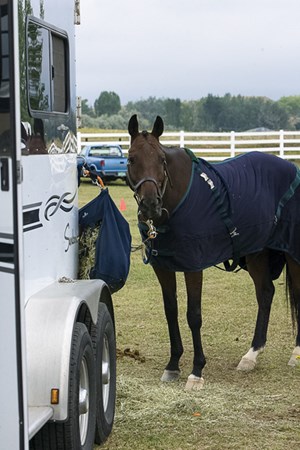You’re on the road with your horse, in an unfamiliar place, when your horse suddenly pulls up lame. Or, he becomes injured. Or colics. Or comes down with a mysterious illness.
 Credit: Heidi Melocco If your horse suffers an injury or illness when you’re on the road, follow these steps to find a reputable veterinarian, ensure optimal care for your horse, and follow up with your own vet when you return home.
Credit: Heidi Melocco If your horse suffers an injury or illness when you’re on the road, follow these steps to find a reputable veterinarian, ensure optimal care for your horse, and follow up with your own vet when you return home.You’re miles from home — and your familiar veterinarian. What should you do? First, stay calm. Then follow these seven steps.
1. Find a veterinarian. Finding a reputable vet is your first concern. If you’re with locals, ask them who to call. If you’re on your own, use your laptop or mobile device to locate the nearest equine veterinarian.
USRider Equestrian Motor Plan™ offers emergency trip-interruption veterinarian referral services to members. (To join, go to www.usrider.org.)
Another good resource is the American Association of Equine Practitioners; this organization’s Get-A-DVM feature allows you to fill in any city and state, and get the names of AAEP members. (Go to www.aaep.org/info/getadvm.)
You can also try to reach your own veterinarian for a referral. Or, you might be lucky enough to be near a large-animal teaching hospital or a major equine clinic. The important thing is to find a vet, and then help him or her help your horse.
2. Pull your horse’s medical records. Whenever you leave home, no matter how short of a trip, take your horse’s medical records. If they’re on your computer, print out the records so you have them handy no matter where you are.
These records include your horse’s current Coggins test (for equine infectious anemia), vaccination records, deworming records (including products used), and his baseline vital signs. Baseline vital signs are those taken when your horse is home, healthy, and rested. You’ll take these readings over a period of several days, at different times of the day, then average out the numbers.
If your horse is insured, keep handy all equine-insurance information (company, agent, and hotline number). You also need to include the basics: Your horse’s age, breed, gender, and use.
Include notes on your horse’s normal eating and drinking habits, a list of any medicines and supplements he’s receiving, his disposition (calm/laid-back vs. nervous/excitable, aggressive vs. passive, etc.), his farrier records, and anything else that might be useful for a vet to know about your horse.
If your horse requires veterinary treatment on the road, pull this folder, and be ready to give it to the emergency vet. (After the vet treats your horse, be sure to update your horse’s medical records to reflect all diagnostic tests, treatment, and medications he received.)
3. Take your horse’s vital signs. Take your horse’s temperature, pulse, and respiration. Also check capillary-refill time: Press down on his gums, and see how long it takes for them to return to their normal color. (It shouldn’t take longer than two seconds.) The emergency vet can then compare your horse’s vital signs with the baseline records.
If your horse appears to be colicking, listen for gut sounds on both sides of his abdomen with a stethoscope. You want to hear rumbles of a healthy gut; faint sounds or silence can indicate a potentially life threatening colic. Seek emergency medical attention immediately.
4. Keep your horse calm. You can do almost anything with your horse provided that you can keep him calm. On the other hand, if he’s in pain, afraid, and/or agitated, he can quickly become resistant and uncooperative. Some horses become even more agitated when being handled by a stranger.
Help your horse stay calm by remaining quiet and calm yourself. Your instinctive reaction may be to hyperventilate and talk fast, but this is the last thing you want to do. Instead, breathe deeply, and speak slowly in a low voice. This will reassure your horse that you’re neither upset nor angry, and all is well.
You’re the other half of your horse’s herd — his reactions will be strongly influenced by your calm presence, both while waiting for the vet, and during diagnosis and treatment.
5. Communicate clearly. The emergency vet will want to know what made you call; that is, what signs of distress you observed and how long you’ve observed these signs. The vet will also want to know what you see at that moment and your horse’s current vital signs.
Report, according to your best estimate when your horse last ate, drank water, urinated, and passed manure. If there was an accident, be prepared to report what happened, and what time it happened. If your horse seems ill, report when you first noticed there was a problem. Tell the vet about any first-aid measures you took while waiting for help.
Ask whether you can offer your horse water and feed while you wait. You’ll likely be asked not to administer any drugs until the vet has seen your horse.
When the vet arrives, stand back, and let him or her assess the situation. Hand over your horse’s medical records, then answer any questions as thoroughly as you can. Be specific.
Communication can be difficult when you’re upset, anxious, and talking to a stranger. Keep in mind that not all vets have a great “barnside manner.” Competence is essential, but a charming personality (although welcome) is not! Be patient, and answer questions to the best of your ability.
Your horse’s records will help the vet accurately assess your horse’s condition. For example, knowing that your horse is usually energetic will help the vet know that your horse’s apparent calm demeanor isn’t typical and may indicate shock and/or blood loss.
 Credit: Heidi Melocco You’re likely accustomed to vets who make farm calls, treat your horse, and send you a bill. In an on-the-road emergency, expect to pay in full on the spot.
Credit: Heidi Melocco You’re likely accustomed to vets who make farm calls, treat your horse, and send you a bill. In an on-the-road emergency, expect to pay in full on the spot.6. Pay in full. You’re likely accustomed to vets who make farm calls, treat your horse, and send you a bill. In an on-the road emergency, expect to pay in full on the spot. Most vets and veterinary clinics take credit cards, and most will give you an estimate for any diagnostic tests required followed by another estimate for treatment.
You may be asked to fill out an emergency-care form with information about your horse and yourself, as well as your signed promise to pay. Don’t see this as insulting in any way. Of course you intend to pay, but the vet doesn’t know you. It’s a precaution that enables him or her to stay in business.
7. Follow up. No matter what your horse requires in terms of immediate diagnostic tests and treatment, be sure you understand fully the immediate follow-up care you’ll need to give your horse until you reach home. Ask for specific, detailed instructions — you’ll want to take the best possible care of your horse until you can see your regular vet.
If you know when you’ll return home, call your horse’s regular vet immediately, and make an appointment for follow-up care as soon as possible after you return. The emergency vet’s discharge record will describe exactly what was done, thus allowing your regular vet to evaluate your horse’s progress.
Jessica Jahiel, PhD (www.jessicajahiel.com), is an internationally recognized clinician and lecturer, and an award-winning author of books on horses, riding, and training. Her e-mail newsletter (www.horse-sense.org) is a popular worldwide resource.
Save





